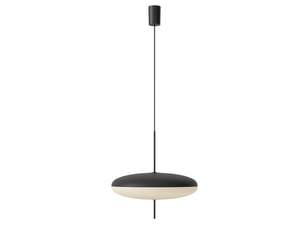From Made in Italy to Scandinavian minimalism: the icons that shaped design history
From radical creativity to the purest essential forms, this selection brings together design icons that transcend generations and styles. To celebrate Elle Decor Italia’s 35th anniversary, Mohd explores a collection of masterpieces that continue to inspire contemporary interiors — where innovation, memory, and vision converge.



Inspired by the 1960s and a passion for color, the Flowerpot VP9 by Verner Panton for &Tradition is a portable lamp that merges pop spirit, function, and freedom. Rechargeable, lightweight, and unmistakably iconic, it embodies a playful approach to design that decorates with personality and without constraints.

Inspired by the 1960s and a passion for color, the Flowerpot VP9 by Verner Panton for &Tradition is a portable lamp that merges pop spirit, function, and freedom. Rechargeable, lightweight, and unmistakably iconic, it embodies a playful approach to design that decorates with personality and without constraints.
A true archetype of modular design, the Componibili by Kartell, created by Anna Castelli Ferrieri in 1967, redefined form and function. Their versatility, rounded shapes, and enduring lightness allow them to live effortlessly in any space, still embodying a contemporary spirit more than five decades later.

Designed in 1970, the Camaleonda by Mario Bellini is a manifesto of free comfort. Reissued by B&B Italia, it stands out for its infinite modularity, transforming into a flexible system of geometric elements. Each module acts like an architectural pixel — allowing endless compositions and inviting a personal, ever-evolving interpretation of space.

Part mirror and part luminous sculpture, the Ultrafragola by Ettore Sottsass for Poltronova features a sinuous silhouette reminiscent of flowing hair. Presented in 1970 at Eurodomus 3, it belongs to Sottsass’s Grey Furniture series, a radical vision that reimagined the boundaries between art, light, and domestic space.

More than a coat rack — a pop icon. The Cactus by Gufram, designed by Drocco and Mello, is handcrafted from expanded polyurethane. With its four arms and over two thousand hand-finished, hand-painted protuberances coated in Guflac®, it perfectly balances irony and craftsmanship. Its surface feels soft yet resists time, making it both playful and enduring.

In Isamu Noguchi’s Akari Light Sculptures, including the UF3-Q for Vitra, light and material coexist in perfect harmony. Noguchi chose the Japanese word akari — meaning both “light” and “weightlessness” — to describe these ethereal creations, inspired by traditional paper lanterns from Gifu, where the first sketches were made.

Designed in 1969 by Afra and Tobia Scarpa for Cassina, the Soriana is an embrace of fabric and steel. Its ingenious construction — a soft volume shaped by a metal clamp — marked a revolution in upholstered furniture. Informal, inviting, and effortlessly elegant, Soriana won the 1970 Compasso d’Oro for its structural simplicity and expressive beauty.

The Shell Chair by Hans J. Wegner for Carl Hansen & Søn is a love letter to form. Originally designed in 1963 and reintroduced in 1998, its three-legged frame and graceful curves offer visual lightness and exceptional comfort, perfectly expressing Wegner’s sculptural and humanist vision.

Archibald by Jean-Marie Massaud for Poltrona Frau represents a new kind of classic. Wrapped in naturally creased leather, this armchair blends artisanal precision with contemporary refinement — an invitation to everyday relaxation, where comfort and elegance coexist in perfect balance.

Designed in 1958 for the SAS Royal Hotel in Copenhagen, the Egg Chair by Arne Jacobsen for Fritz Hansen remains one of the most recognizable silhouettes in design history. Shaped like a protective shell, its fiberglass frame is padded with soft foam and rests on a swivel aluminum base — an icon of privacy, comfort, and timeless style.

A symbol of the Memphis movement, the Kristall Table designed by Michele De Lucchi in 1981 is a playful explosion of geometry and color. With its bold forms and irreverent spirit, it broke conventions to embody the radical freedom that defined an era.

A masterpiece of 1950, the Flag Halyard Chair by Hans J. Wegner, produced by PP Møbler, unites steel, rope, and leather in a surprising balance of rusticity and sophistication — an emblem of comfort as experimentation.

Designed in 1964 by Poul M. Volther for Fredericia, the Corona Chair is a study in sculptural minimalism. Its four floating, elliptical sections seem suspended in midair, supported by a sleek steel frame — a futuristic icon of Danish design audacity.

The Stringa armchair by Gae Aulenti for Exteta, designed in 1963, brings Italian architectural vision outdoors. With its structural minimalism and sculptural strength, it stands as a rare and powerful piece — a statement of form and presence.

Unconventional and dynamic, the Botolo designed by Cini Boeri for Arflex in 1973 introduced a new way of living. With adjustable legs and integrated wheels, it transforms from a dining chair to a low, informal seat — a symbol of movement, versatility, and modern comfort.

Designed in 1972 and reissued by Tacchini, Le Mura by Mario Bellini merges proportion, ergonomics, and a social conscience. Its modular structure, inspired by ancient Roman walls, allows infinite configurations that adapt to any environment while preserving strong expressive and formal integrity.

Nella scelta delle icone presenti in questa selezione, Mohd si fa interprete di un dialogo tra passato e presente, spunti per immaginare il domani dell’abitare
We turn your inspiration into a project
We help you shape your home, collecting the best inspirations for you and editing design selections that fit your space and needs.




















































